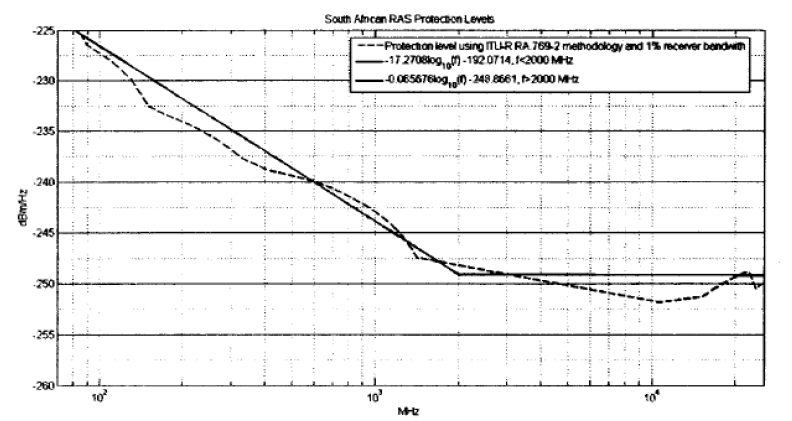 Public Service Commission Act, 1997
Public Service Commission Act, 1997
R 385
Astronomy Geographic Advantage Act, 2007 (Act No. 21 of 2007)RegulationsRadio Astronomy Protection Levels Regulations2. Protection levels |
| (1) | The origin, derivation and references for the protection levels to be applied in astronomy advantage areas declared for the purposes of radio astronomy are as follows: |
| (a) | The protection levels are derived using the methodology described in ITU Recommendation ITU-R RA.769. |
| (b) | The technical assumptions made in the derivation are that receiver and sky temperatures are linearly interpolated from those values found in ITU-R RA.769, and that receiver bandwidth is assumed to be 1% of the observing frequency. |
| (c) | Derived protection levels, which are equivalent to threshold levels of interference for new generation radio astronomy observatories and are based on the methodology outlined in ITU-R RA.769, are depicted in Figure 1. |
| (2) | The protection levels to be applied in astronomy advantage areas declared for the purposes of radio astronomy shall be as follows: |
| (a) | The values of the protection levels at the applicable frequencies are determined by means of a linearly piecewise function. |
| (b) | The said function is described by the following equations, which are to be used to calculate the required protection level at any frequency in the spectrum from 70 MHz to 25,5 GHz: |
SARAS [dBm / Hz] = - 17.2708 log10 (f) – 192.0714 for f < 2 GHz.
SARAS [dBm / Hz] = - 0.065676 log10 (f) – 248.8661 for f ≥ 2 GHz.
The values of (f) are to be in MHz.
| (c) | The function is designated as the South African Radio Astronomy Service ("SARAS") protection levels. |
| (d) | The SARAS protection levels are reflected in Figure 1 below, together with the ITU interpolated continuum threshold levels of interference. |
Figure 1. SARAS Protection Levels

| (e) | Owing to the variety of units used within the electronic communications sector, the following list of unit conversions is provided (assuming an isotropic radiator): |
dB(W / m2 / Hz)→ dBm : SPFD – 20log10(f) + 10 log10(Δf) + 188.5
dBm → dBm / Hz : dBm – 10log10(Δf)
dBW→ dBm : dBW + 30
dBW → dB(W / m2) : dBW + 20log10(f) – 158.5
The values of "f" and "Δf" are to be in Hz.